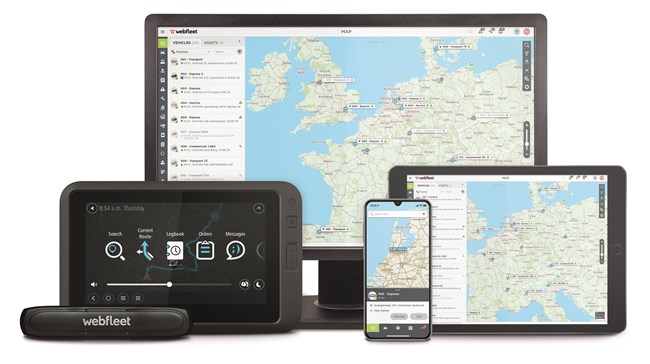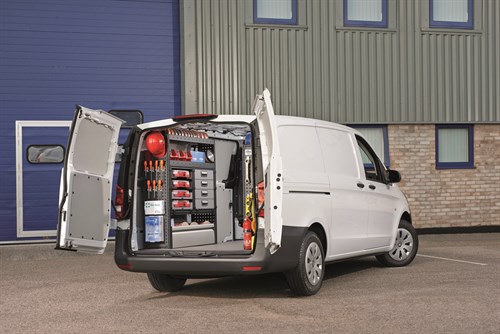- Northgate launches micromobility service
- Progress being made on shared EV charging, AFP reports
- Medisort electrifying van fleet with Bedeo
- ADVERTISEMENT FEATURE: Taking a shortcut to reduce commercial vehicle emissions
- The What Van? Road Test: Ford Ranger Raptor
- Speakers announced for Commercial Vehicle Show
- Check new vehicle registration details are correct, AFP tells fleets
- New Market Analysis: Large Vans
- Increasing proportion of leased vehicles now LCVs, BVRLA reports
- Enterprise announces commercial vehicle technician recruitment programme
What Van? Awards 2022: Green Innovation Award – Webfleet Solutions
Date: Friday, December 17, 2021

Webfleet Solutions, known as TomTom Telematics until October 2019, has over 50,000 customers worldwide, serving drivers in over 100 countries with its portfolio of vehicle telematics and connected vehicle services. The product ‘WEBFLEET’ is used by businesses of all sizes to improve overall fleet efficiency with fuel savings and support for drivers.
Webfleet Solutions claims that, as Europe’s leading telematics provider with ISO 14001 : 2015 accreditation for environmental management, they recognised that for road transport to achieve a zero-emissions future action is not only needed from government but also from industry suppliers.
As part of its commitment to sustained investment in advanced EV fleet management innovations it has developed a software solution that forms part of the WEBFLEET system.
With the unique challenges that adopting an EV presents, the Fleet Electrification Planning Report is located centrally within the WEBFLEET EV toolkit and enables fleet managers to identify which of their current conventionally powered vehicles would be suitable for replacement with an electric alternative.
As the official, published ranges of electric vehicles can be greatly affected by factors such as payload, weather conditions, terrain and driver behaviour accurate information available to a fleet manager to enable the right decision to be made is scant. Users of WEBFLEET can draw on the telematics from existing vehicles currently in use which will give a much more accurate guide to real world ranges and the potential for a particular van to be fit
for purpose.
When these vans are in operation with a WEBFLEET user, there is ability to efficiently plan workflow using real time battery state of charge and the real world range left remaining. Pre-emptive action can be taken with suitable charging points being highlighted to the driver’s navigation device, again enhancing efficiency and ensuring that the day’s tasks are completed with minimal downtime.
The WEBFLEET EV toolkit also includes a Charger Connection Report.
Helping to maintain charge levels within the ideal 20–80% window to minimise battery degradation, it also ensures that charging occurs at the times when the cheapest tariffs are available.
The latest enhancement to the WEBFLEET product portfolio is the Energy Consumption Report. With a breakdown of the energy consumed by driving and other uses such as auxiliary equipment, fleet managers can compare the performance of individual vehicles and highlight any areas of concern. Also displayed is the amount of energy that has been created through regenerative braking, a process that can add range to the vehicle therefore reducing operating costs.
Webfleet Solutions supplies the product to Oxford City Council, a local authority that is a flagbearer for transport decarbonisation. Not only has the platform been selected by the council’s public and commercial services division ODS, to cost optimise EV utilisation and charging, a development partnership has been formed between the two bodies to help shape the future evolution of WEBFLEET. This will also serve to maximise its potential, not only for the council but also for new and existing users.
Highly Commended: Modul-System

Although Modul-System is well known for the design and manufacture of lightweight van racking and flooring systems, it has also developed Modul-EV, a unique DC to DC charger.
There is a potential issue when auxiliary equipment draws power from an electric vehicles drive battery (for example, when the conventional standard and any auxiliary batteries are depleted). This reduces the available driving range with the possibility that the driver may have insufficient charge to get to a charge point or to return to base.
When the EV is being charged overnight on the conventional wallbox charge point, the Modul-EV ensures that the vans auxiliary batteries are also charged, together with the vehicles standard 12 volt battery which is required to ‘start’ the van. With these power sources fully charged at the start of the working day, the likelihood of the drive battery being drained is reduced.
View The WhatVan Digital Edition


